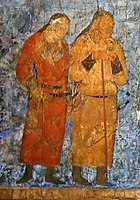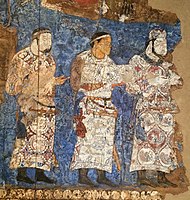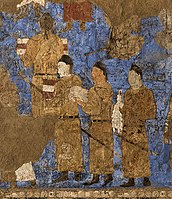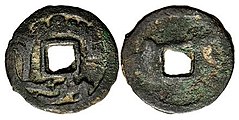
Sogdia or Sogdiana was an ancient East Iranian civilization between the Amu Darya and the Syr Darya, and in present-day Uzbekistan, Turkmenistan, Tajikistan, Kazakhstan, and Kyrgyzstan. Sogdiana was also a province of the Achaemenid Empire, and listed on the Behistun Inscription of Darius the Great. Sogdiana was first conquered by Cyrus the Great, the founder of the Achaemenid Empire, and then was annexed by the Macedonian ruler Alexander the Great in 328 BC. It would continue to change hands under the Seleucid Empire, the Greco-Bactrian Kingdom, the Kushan Empire, the Sasanian Empire, the Hephthalite Empire, the Western Turkic Khaganate and the Muslim conquest of Transoxiana.
Sri Mara was the founder of the kingdom of Champa.

The Afrasiab murals, also called the Paintings of the Ambassadors, is a rare example of Sogdian art. It was discovered in 1965 when the local authorities decided to construct a road in the middle of Afrāsiāb mound, the old site of pre-Mongol Samarkand. It is now preserved in a special museum on the Afrāsiāb mound.
Zunbil, also written as Zhunbil, or Rutbils of Zabulistan, was a royal dynasty south of the Hindu Kush in present southern Afghanistan region. They ruled from circa 680 AD until the Saffarid conquest in 870 AD. The Zunbil dynasty was founded by Rutbil, the elder brother of the Turk Shahi ruler, who ruled over Hephthalite kingdom from his capital in Kabul. The Zunbils are described as having Turkish troops in their service by Arabic sources like Tarikh al-Tabari and Tarikh-i Sistan.

Afrasiyab ,(Persian: افراسيابafrāsiyāb) is an ancient site of Northern Samarkand, present day Uzbekistan, that was occupied from c. 500 BC to 1220 AD prior to the Mongol invasion in the 13th century. The oldest layers date from the middle of the first millennium BC. Today, it is a hilly grass mound located near the Bibi Khanaum Mosque. Excavations uncovered the now famous Afrasiab frescoes exposed in the Afrasiab Museum of Samarkand, located next to the archaeological site.
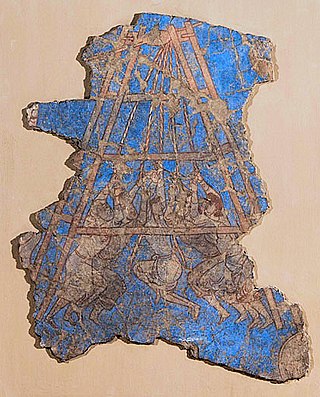
The Muslim conquest of Transoxiana or Arab conquest of Transoxiana were the 7th and 8th century conquests, by Umayyad and Abbasid Arabs, of Transoxiana, the land between the Oxus and Jaxartes rivers, a part of Central Asia that today includes all or parts of Uzbekistan, Tajikistan, Kazakhstan, and Kyrgyzstan.
Gurak or Ghurak was a medieval Sogdian ruler in Central Asia during the period of the Muslim conquest of Transoxiana. In 710, he was installed as king of Samarkand after the populace overthrew his predecessor, Tarkhun, due to his pro-Muslim stance. The Umayyad governor, Qutayba ibn Muslim, campaigned against Samarkand but in the end confirmed Gurak as its ruler. Gurak was a cautious and intelligent ruler, and managed, through shifting alliance between the Muslims and the Turgesh, to remain on his throne. Some time after the Muslim Pyrrhic victory Battle of the Defile in 731, he managed to recover his capital, Samarkand, and achieve a quasi-independence which he maintained until his death in 737 or 738. His realm was then divided among his relatives : Turgar, formerly prince of Kabudhan, received Samarkand, Me-chu'o was king of Mayamurgh, while a certain Ko-lopu-lo who was king of Ishtikhan in 742 may perhaps be identified with Gurak's brother Afarun.

Tarkhun was a Sogdian ruler of Samarkand from somewhere 705–707 to 710. After receiving the news of the capture of Bukhara by the Umayyad general Qutayba ibn Muslim in 709, Tarkhun sent envoys to the latter and acknowledged the authority of the Umayyad Caliphate. His two sons had to be kept at the Umayyad court as hostages.

The Principality of Chaghaniyan, known in Arabic sources as al-Saghaniyan, was a part of the Hephthalite Confederation from the 5th to the 7th century CE. After this, it was ruled by a local, presumably Iranian dynasty, which governed the Chaghaniyan region from the late 7th-century to the early 8th-century CE. These rulers were known by their titles of “Chaghan Khudah”.

Afrasiab Museum of Samarkand is a museum located at the historical site of Afrasiyab, one of the largest archaeological sites in the world and the ancient city that was destroyed by the Mongols in the early 13th century. Museum building and the archaeological site are located in the north-eastern part of the city of Samarkand in the Central Asian country of Uzbekistan. It bears the name of Afrasiab, mythical king and hero of Turan. Permanent exhibition of the Afrasiab Museum of Samarkand is focused on the history of the city itself as well as the surrounding region. The museum building was designed by Armenian architect Bagdasar Arzumanyan in 1970, at the time when Uzbek Soviet Socialist Republic was still part of the Soviet Union. The opening of the museum was dedicated to the 2500th anniversary of the founding of the city of Samarkand. Thematically, the museum is divided into five rooms dedicated to different periods of life in the fort of Afrasiyab.
The Turk Shahis or Kabul Shahis were a dynasty of Western Turk, or mixed Turko-Hephthalite, origin, that ruled from Kabul and Kapisa to Gandhara in the 7th to 9th centuries AD. They may have been of Khalaj ethnicity. The Gandhara territory may have been bordering the Kashmir kingdom and the Kanauj kingdom to the east. From the 560s, the Western Turks had gradually expanded southeasterward from Transoxonia, and occupied Bactria and the Hindu-Kush region, forming largely independent polities. The Turk Shahis may have been a political extension of the neighbouring Western Turk Yabghus of Tokharistan. In the Hindu-Kush region, they replaced the Nezak Huns – the last dynasty of Bactrian rulers with origins among the Xwn (Xionite) and/or Huna peoples.
Li Shunxian was a Chinese poet celebrated for her beauty and poetic talent. She was a concubine of Wang Yan, the Chinese Emperor of Former Shu. She was famous for being a Chinese woman of Persian ancestry who was an accomplished poet in the Chinese language.

The Kaiyuan Tongbao, sometimes romanised as Kai Yuan Tong Bao or using the archaic Wade-Giles spelling K'ai Yuan T'ung Pao, was a Tang dynasty cash coin that was produced from 621 under the reign of Emperor Gaozu and remained in production for most of the Tang dynasty until 907. The Kaiyuan Tongbao was notably the first cash coin to use the inscription tōng bǎo (通寶) and an era title as opposed to have an inscription based on the weight of the coin as was the case with Ban Liang, Wu Zhu and many other earlier types of Chinese cash coins. The Kaiyuan Tongbao's calligraphy and inscription inspired subsequent Central Asian, Japanese, Korean, Ryūkyūan, and Vietnamese cash coins and became the standard until the last cash coin to use the inscription "通寶" was cast until the early 1940s in French Indochina.

Varkhuman, also Vargoman was an Ikhshid (King) of Sogdia, residing in the city of Samarkand in the 7th century CE. He succeeded King Shishpin. He is known from the Afrasiab murals of Afrasiyab in Samarkand, where is seen being visited by embassies from numerous countries, including China. There is also an inscription in the murals directly mentioning him. His name is also known from Chinese histories.

The Tokhara Yabghus or Yabghus of Tokharistan were a dynasty of Western Turk–Hephtalite sub-kings with the title "Yabghus", who ruled from 625 CE in the area of Tokharistan north and south of the Oxus River, with some smaller remnants surviving in the area of Badakhshan until 758 CE. Their legacy extended to the southeast where it came into contact with the Turk Shahis and the Zunbils until the 9th century CE.

Fromo or Phromo Kesaro was a king of the Turk Shahis, a dynasty of Western Turk or mixed Western Turk-Hephthalite origin, who ruled from Kabul and Kapisa to Gandhara in the 7th to 9th centuries. In Chinese sources "Fromo Kesaro" was transcribed 拂菻罽娑, "Fulin" ([[wikt:拂菻|拂菻]]) being the standard Tang dynasty name for "Byzantine Empire".
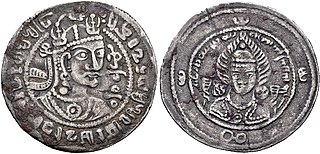
Shahi Tegin, Tegin Shah or Sri Shahi was a king of the Turk Shahis, a dynasty of Western Turk or mixed Western Turk-Hephthalite origin who ruled from Kabul and Kapisa to Gandhara in the 7th to 9th centuries.
The Patola Shahis, or Palola Shahis, also Gilgit Shahis, were a dynasty of Buddhist kings of the Kingdom of Gilgit, located in the northern tip of the Indian subcontinent in the 6th-8th century CE. The Kingdom was located on a strategic trans-Himalyan trade route, now known as the Karakoram Highway, which branched off the Grand Trunk Road. It followed the important stops of Shatial and Chilas.

Tūrgār, also Thurgar was a medieval Sogdian ruler in Transoxiana and successor to his father Ghurak during the period of the Muslim conquest of Transoxiana. He was the last ruler of Samarkand and its surroundings from ca. 738 until no later than 755/57, until the Arabs took full control of the region. He was an Ikhshid, a princely title of the Iranian rulers of Soghdia and the Ferghana Valley in Transoxiana during the pre-Islamic and early Islamic periods.

Ghar-ilchi was, according to Chinese and Arab sources, a local king of Kapisi and the twelfth and last known ruler of the Nezak Huns. Ghar-ilchi may have been the last member of a local "Khingal dynasty" founded by Khingila, the Alchon Hun ruler.




